Blog
Op de hoogte blijven van mijn blogs? Abonneer je op mijn nieuwsbrief.-
Lieve Wim
31 maart 2023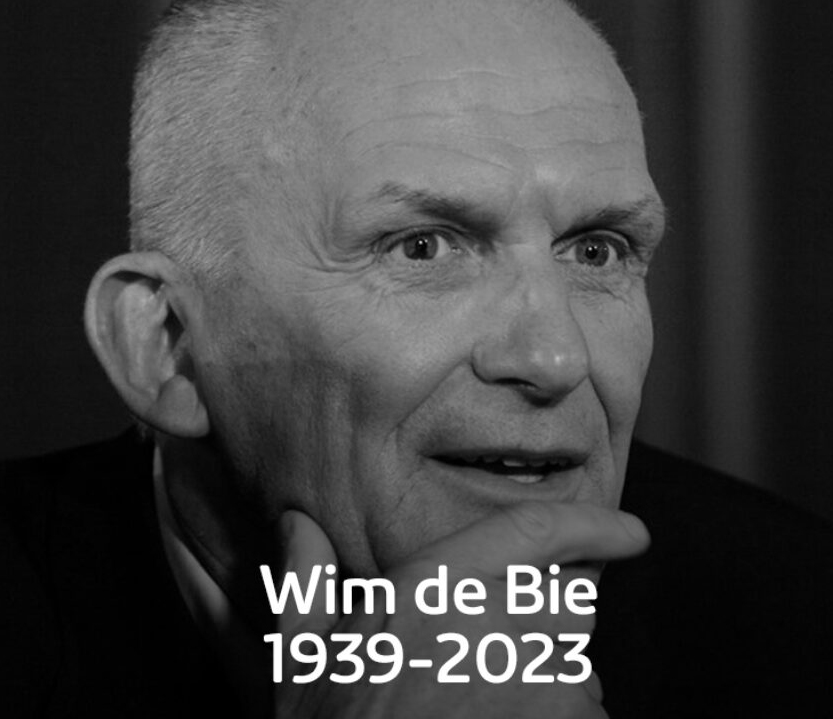
BLOG 012
Lieve Wim
When the norm these days is 'The Next Big Thing', individualism, egoism, the opposite of being modest, nice and shy, last Monday, the 27th of March 2023, the Netherlands lost a great bright, smart and sweet sole, Wim de Bie.
Wim de Bie was 1 side of the duo 'van Kooten en de Bie' and where from 1983 till 1998 my heroes, Sunday evening, after the 8pm news, brought their 30 to 40 minutes reflection on the last week. They all did this with simple means and with a small team with small changes when needed. Van Kooten en de Bie, a cameraman, sound man, director and make up artist. The settings where in houses of those team, in streets where they lived, etc. Keep it close and simple, the acting and there types and roles where superbe.
Why I write about Wim de Bie and 'van Kooten' is because they shaped me, they learned me to be critical without shouting, stay true to yourself, use simple stuff around you to exress yourself, they gave me and my family (father, mother and brother) 30 minutes of joy every week, critical thinking, staying close to yourself and stay modest, while their use of language was brilliant (a word I hardly like to use, I am not a language purist) and the way they played / acted some stereo types. I also think Wim de Bie is a moralist like me, and could get really angry on TV, real anger, which was new at the time. Anger about injustice, real outed on TV. Still Wim was way more intelligent that me and brought it with reflection on himself and humour.
And again, I like to stress that they all did this with the simplest of means. Simple elements, no studio's, high expenses on renting actors, acting stages, etc. A second hand jacket, old trousers and another pare of glasses where enough, the acting did the rest. They stopped with being a duo in 1998, and that was a shock, but now, after all these years I understand it. Going on, after 38 years of being together on TV, it was enough and you don't know where the fame will bring you, into craziness or getting too arrogant, it will affect the quality. And from high quality it was of the highest level.
Thank you Wim, you will be missed.
Thanks for being a teacher, a leader, showing me a way...................
Lees meer >> | 711 keer bekeken
-
White Reliefs / Normal Patterns
9 maart 2023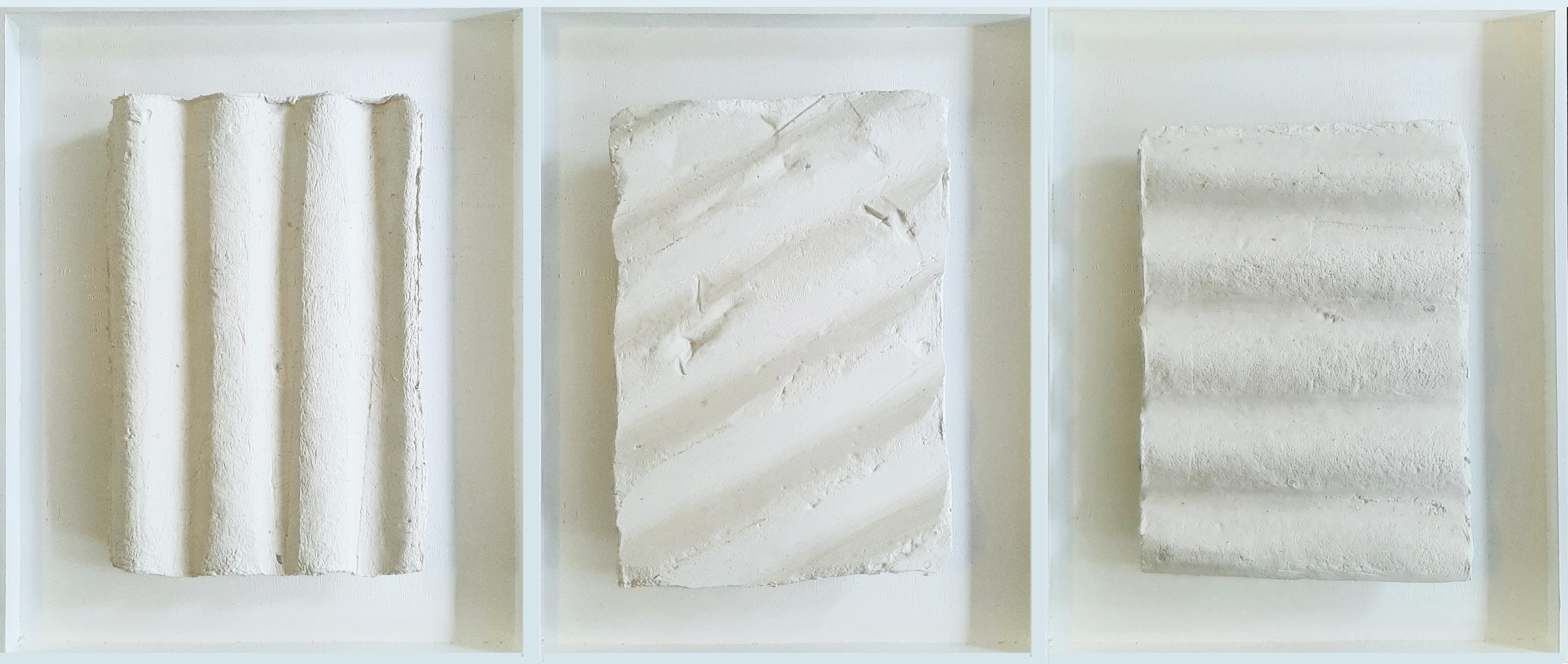
BLOG 011
White Reliefs / Normal Patterns
As an artist who could not align his portrait paintings with is love for conceptual installation art, which basically is, in simple words, everything except choosing just for painting or just for sculpture, the artist was very happy when he found himself making reliefs in the carton pierre technique, the plaquettes of recycled paper, Gipsen, water and wood glue filled with tree seeds. If buyers get bored with what they bought, they can burry the art work, and grow trees. And this is essential. That an art work can be buried, gone. It is essential because my portrait paintings where not able to do that, that you would call destroying art, or put it in a corner on the attic, while with these tree seeds invested white reliefs, there is still another life in them.
The reliefs are white, in which in my conceptual art work often, they are portable, they are sellable, they can be put in the ground to grow trees. What is there not to like? For me this was, after working with non sellable art, not necessary by choice, a gift. A dream came through. Maybe you are now wondering: why not sooner? Well, my idea’s where there, but not to be executed because of brain fog and sometimes ting simple are not coming together. It came together end 2022, in Dili, Timor-Leste. And when the idea is there, and it works, afterwards you think: why not sooner? This is simply how life goes.
The ‘burry the art work’ is besides growing trees, also a reminder that whenever an artist gets big, he/she/x is unable to do anything wrong, and this art will never be devaluated when it is in the collection of museums and super rich collectors. They would simply not allow it. Hence the shit art we see coming out of some of the biggest artist, like Hirst and Koons, or artist start working larger and larger, not able to think small anymore, humble, poetic, etc. Look at Anish Kapoor. Great artist, but where is the limit of large? And super large is also a bit arrogant, ignorant to others in our life. The large is so large, we can’t reach for it anymore, unable to comprehend it size. It is getting in to a circus act, spectacle art. Which for me, is neither interesting, neither good or important. And look in to the western art world, when an artist gets his 15 minutes of fame, a solo in a museum: the work gets 5 to 10 larger than before. While size does matter, also for your concept, so, why change this when getting in to the eye of a museum director, curator or rich collector? If you want to know more about: look at: exit through the gifts shop, Adam Ruins Everything - How the Fine Art Market is a Scam: https://www.youtube.com/watch?v=Dw5kme5Q_Yo.Lees meer >> | 321 keer bekeken
-
How to bury an art work and why
28 februari 2023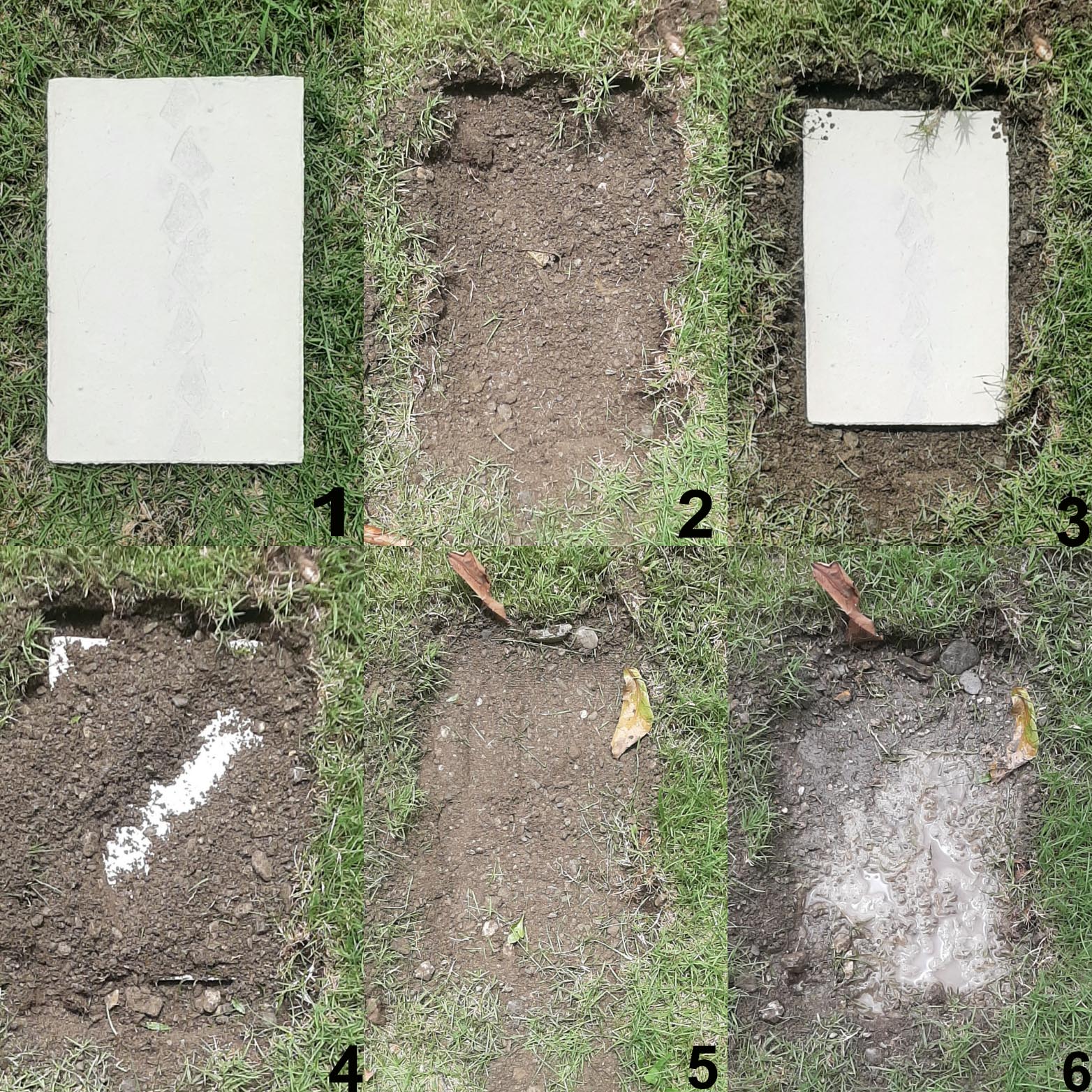
BLOG 010
How to bury an artwork.
Relief 0016 is buried. A relief made in the Carton Pierre technique, filled with tree seeds. When a buyer is done with this artwork, it still has the potential to become seomthing else, in this case a tree.
To test if the seeds will grow out in to a tree.
How to bury:1: place the relief on the ground
2: make a hole just big enough
3: Put the relief in to that hole
4: put sand over it
5: cover it completely
6: add water.
After 5 weeks we had lift off:
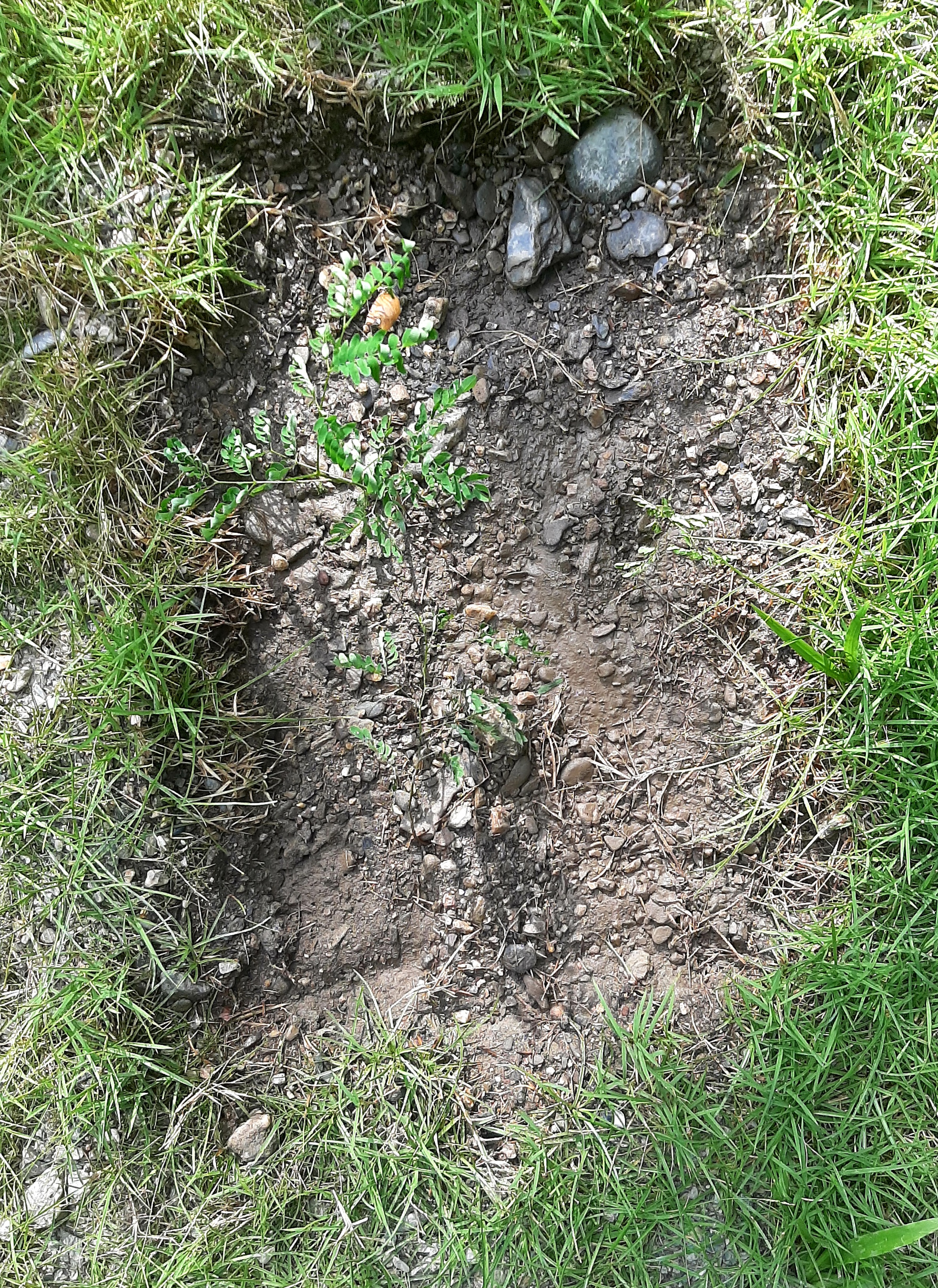
Lees meer >> | 406 keer bekeken
-
FUTURE FORESTS ART / APAGA
2 augustus 2022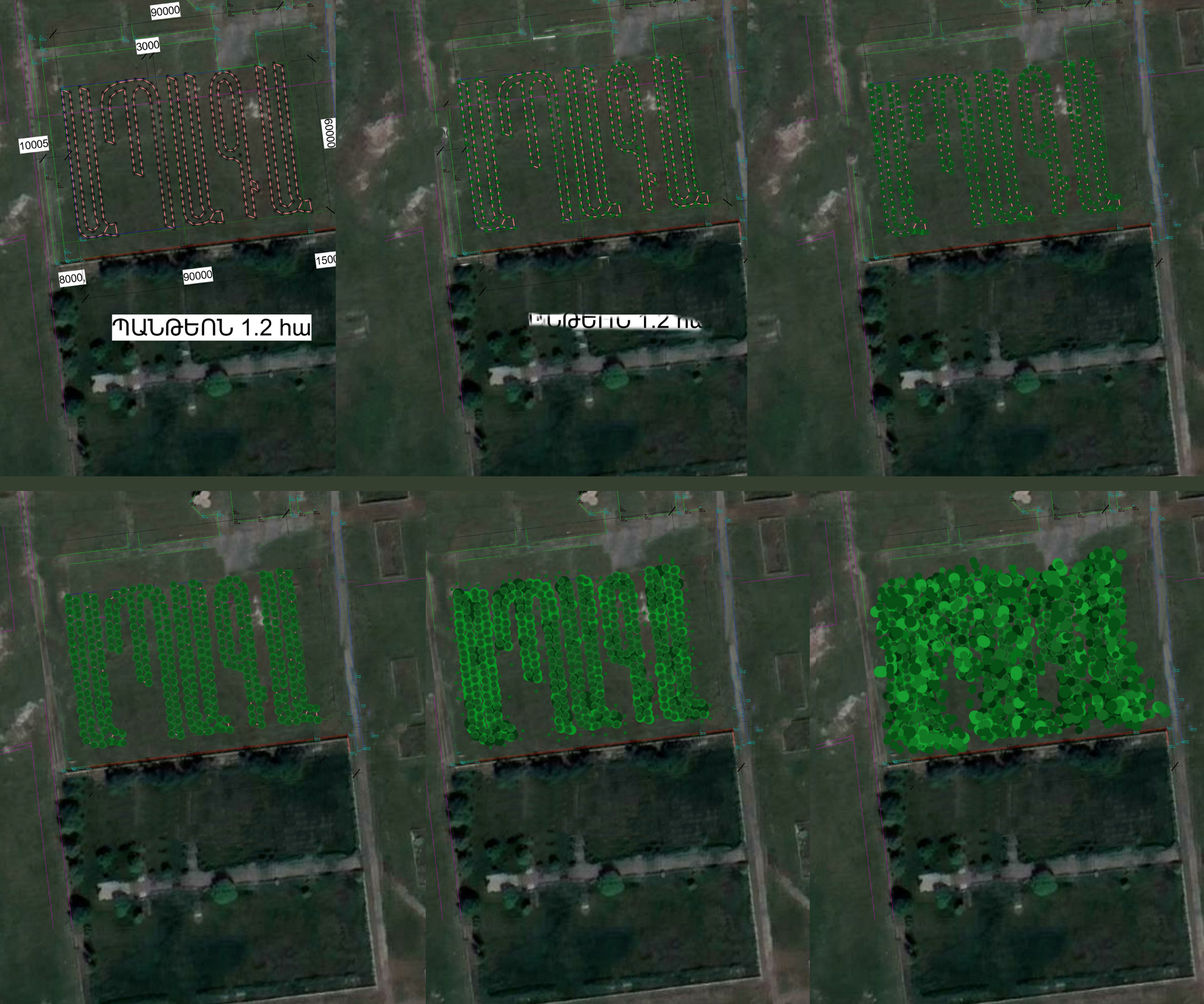
BLOG 009
ECO ART, OR WHATEVER WE CAN DO TO GIVE BACK, AS ARTISTS
Subtitle:
Reflection on art that is truly green (or as green as possible) and giving back to the community.
In a respond to the question they asked me before coming to Sevan, Armenia, in the beginning of 2022, on what is ‘Eco Art’, I reflected on this question then and now, after being back from planting 404 trees in Sevan, Armenia in the word APAGA (future). My reflection started with realising I don’t necessary identify with a group of artists calling themselves Eco Artists, if they exist at all, being a group at all.
The google definition of what Eco Art could be, is more or less: Ecological art is an art genre and artistic practice that seeks to preserve, remediate and/or vitalize the life forms, resources and ecology of Earth. Ecological art practitioners do this by applying the principles of ecosystems to living species and their habitats throughout the lithosphere, atmosphere, biosphere, and hydrosphere, including wilderness, rural, suburban and urban locations.[1][2] Ecological art is a distinct genre from Environmental art in that it involves functional ecological systems-restoration, as well as socially engaged, activist, community-based interventions.[3] Ecological art also addresses politics, culture, economics, ethics and aesthetics as they impact the conditions of ecosystems.[4] Ecological art practitioners include artists, scientists, philosophers and activists who often collaborate on restoration, remediation and public awareness projects.
In which I miss: the artist himself tries to work as “green” as possible, thinks about the ethics and morals of the project itself and the ethics/morals of the country and/or people, organisations it works for. In which in my thinking Richard Serra working for Qatar (East-West/West-East, 2014) is not a green way of making art. And also, Damien Hirst letting a Tiger shark being killed in Australia, shipped to England and put in formaldehyde solution in a glass thank to create ‘The Physical Impossibility of Death in the Mind of Someone Living’ (1991) is even moralistic repelling in the since of animal rights ethics and shipping it all around the world to having him the personal pleasure getting famous and rich (if you didn’t know, he did this with sheep, lamb, another tiger shark, etc.). That Museum Louvre worked together with Abu Dhabi creating a sister museum Louvre in the capital Abu Dhabi is also not a very ‘green’ way of helping another country knowing it is all dirty oil money. Of course, there are worse and far more bigger polluters in the world, but the art world is supposing being critical, and I don’t see that for the last 30 years. Like the Stedelijk Museum Amsterdam is getting sponsored by TaTa steel, ABN Amro (one of the biggest banks in holland giving loans to intensive farmers to expand their businesses (intensive cows, pigs and chicken farmers) even more, polluting even more) and Audi, which I think is something to reject immediately.
With all this in mind, I got the extra motivation to start the idea of planting FUTURE forests world wide, which means going to all (officially stated) 195 countries and execute these plans. In the course of the project, I know I will find a way to travel around in a less polluting way than flying. For now, I stopped eating meat, after already buying more ecoclinal sustainable clothing for years now, resent fast fashion, fast food, having no kids, don’t use single used plastics, Pay Pall, Amazon, etc. buying more local and not stupid unnecessary stuff, voting green, never had a car before I was 40, etc. I also compensate generously my flying behaviour through TreesForAll.nl. Besides all this, I only can be honest abut the fact that I am a polluter as well, but not the biggest one. In this mind I went to Sevan Armenia, going to plant far less tress than I initial wanted (5000), because I found out that the time was to short, but also the local water supply way to insufficient to do this. And if I don’t start with this project, I also will not learn how to move on in the future and how to improve my plans.So, the APAGA FOREST was planted April 23, 2022 in Sevan, Armenia with 150 kids. It was an art work I designed in response to an open call (International Art residence), launched by EU4Culture further implemented by: Regional Development and Research Centre, Sevan Community Municipality, ''Sevan Youth Club‘’ and New Art Stage (NAS).
APAGA forest was sketched by Hayk Babayan and plotted with the help of his father (both architects), in an old soviet park near Sevan city, Armenia. APAGA forest was planted with 404 (196 trees growing on the side in case some trees die) pine tree yearlings (Pinus Sylvestris) and need growing, after 10 years, it will be more visible from above, after 10 to 20 years the expectation is that also the round around will be changing and without grooming the forest will expand and the letters will more and more disappear in the future process of growing (in the picture you see 6 stages of the planting and growing over time, approximately 15 to 25 years).
With the high deforestation in the world, the massive bush fires in California, Australia and the Tundra of Russia for example, exhausting Co2 is going even faster. For me as an artist to give back, is to make these super large installations, world wide, in every official country of the world we call earth, planting FUTURE forests, in the local language as a mean to keep on communicating, showing this is possible and seeding seeds in the heads of who is helping me. The real FUTURE, by the way, is not the word planted, stating FUTURE, but the forest that will grow out of it. And I believe that because it is art, the protection will be sufficient. Also, the way the forest will be planted is very important, as it will be done together with the community, preferable youth, with artists talks and all, making them fulling super involved, because they have the future, hopefully a greener future. This all sounds super positive and great, but it is also how to deal with my own fear losing the green world, and what to do about global warming with falling, greedy world leaders.
The forest I planted looks like a mono culture, with 404 Pine trees, but will be left growing on their own pace and no trimming, and are indigenous to the location. And I am in good communication with the team there, so, after 2 or 3 years, I will ask them to plant some bushes, flowers and other trees, that will go well together with the trees as well, to maximise biodiversity.
With biodiversity is meant, all species together (trees, plants, birds, insects, etc.) that, voluntarily live, on a piece of land. For instance, in holland we now have very green grasslands for cows, that are treated in a way they have less than 40 species, which we now can call green desserts. Then we have cultural forests with 300 species and food forests with more than 600 species. A food forest is a permaculture forest that also delivery crops like apple, pear, nuts, grana, fruits, etc.
For my future FUTURE forests project, I would like to get this permaculture knowledge more involved in my forest projects. As Co2 storage for the future is one thing, creating a bigger biodiversity is a must too. But this first FUTURE / APAGA forest was a big success in being inclusive with the youth, youth centre Sevan and the community of Sevan. Though a greater success could have been succeeded if I would have got more time, and could have more talks with the permaculture specialist. But besides that, I think 200 people in Sevan where very enthusiastic and my message reached them. Also, my sponsors, 56 of them, followed the process closely and hopefully some of them will stick with me and this project. Let’s see what grows out of this more.Lees meer >> | 347 keer bekeken
-
Shitty Fast Fashion
1 augustus 2022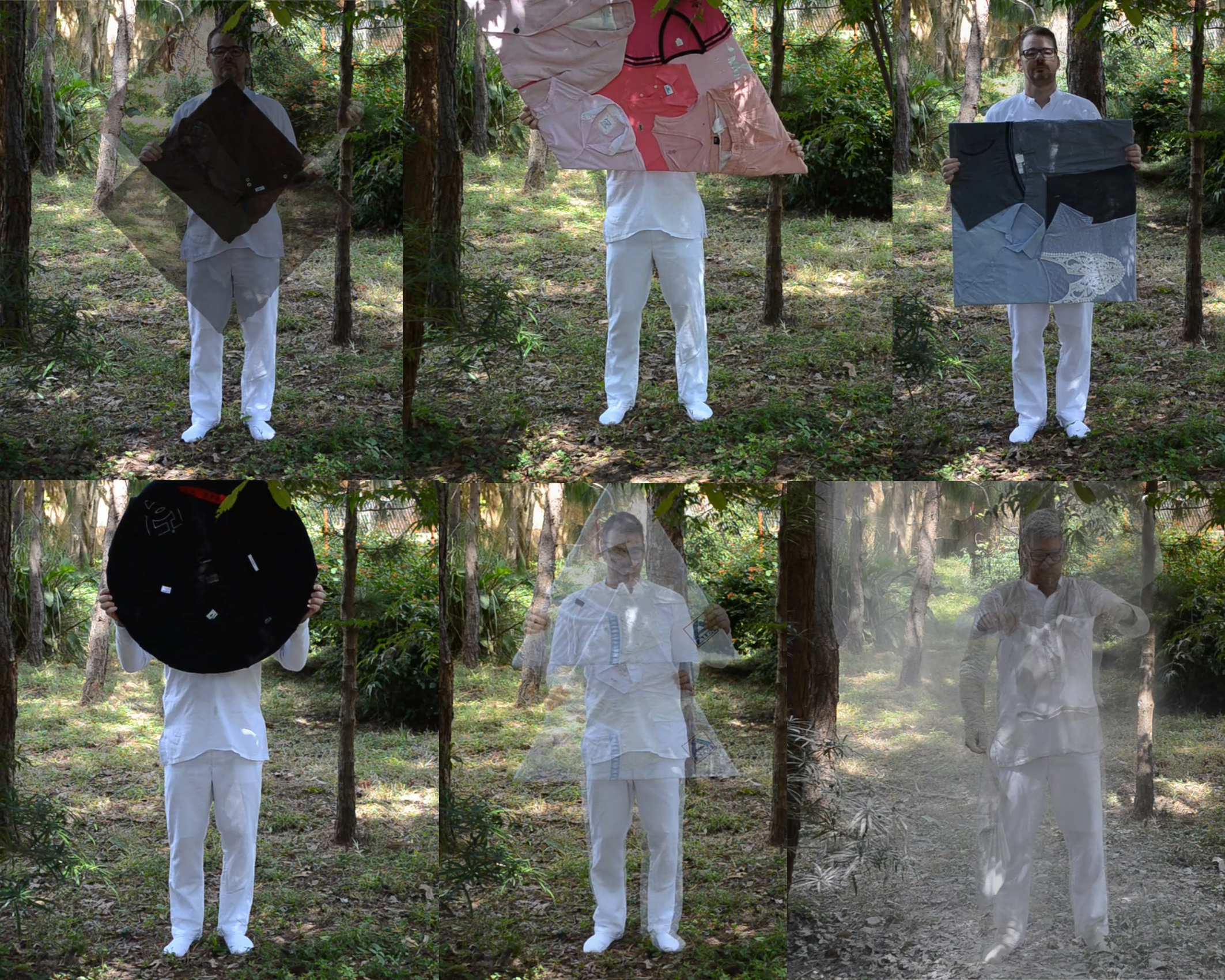
BLOG 008
Performance and Installation art work:
Title: 3rd hands clothes for(m) me
Pink, Brown, Black, White, Grey and Ashes
Second hand DAPP clothes, 5 stretcher frames in mathematical forms
75cm high x 100cm wide x 4cm deep
This artwork is first and foremost about #nature, #climatecrises, #globalwarming, #pollution from the #FastFashion #industry and our ability not to change but are very good in clothing our eyes and ears to the facts, for something not important. We don’t need to change our garderobe 4 times a year.
So, for this performance I used second hand, fast fashion, clothes from DAPP (Development Aid from People to People), Lilongwe Malawi. Well-meant second-hand clothing, from The West, shipped to Africa, destroying local textile industries and local entrepreneurs. Mismanaged on site (DAPP stores over Malawi) also had its part in this bankruptcy. In which I mean: while the mindset is on having items to sell, profiting a few, make money and some have a job, the big profit, and “the lead” will still stay in The West.The Western Fashion (clothing) industry sponsors this ‘funny’ and shady trade (and Western people supporting it): in The West they think it is donated, in Zambia and Malawi it is sold, a part of it by DAPP, turning it in a donation again. And hence the pollution of the fast fashion industry already has been there before shipping, all the water spillage (growing cotton, washing, dyeing, washing) and Co2 exhaust by the transport (from Bangladesh sweat shops), child-labour in other 3rd world countries to make it affordable in The West, so we can, after wearing it for a short period (give) it away (and feel so good) to “Africa” (like our old polluting cars), another “third world country” (I am not supporting this terminology, I am using it here cynically). With all these second hands clothing, Zambian and Malawian traditional clothing and / or clothing styles that would evolve with the lack of these (not so) old (not worn out (so not efficient and supporting the clothing industry) clothes, is very much disrupted and vanished. Which is not only a loss of local job options, but very much a cultural loss. Besides this latter 2 points, this way of the shipping and than selling 2nd hand cheap clothes has also destroyed the textile industry in Zambia and Malawi, because local produced clothing is still more expansive than these 2nd hands clothing from The West.
As my thoughts where at the time of creating: ‘this system let us all go to hell’, I performed with these forms in nature, holding them up in my white suit (clown / court jester / village fool, The White Western Man) and ending with smashing ashes around, ashes from pervious burned art works.
My last point to state: supporting fast fashion and the other fashion forms, is also closing your eyes for the big problems fashion is causing.
About the mathematical forms:
All over the world mathematical lessons are given and almost everybody will get lessons about the surface / perimeter of a triangle, square and circle. To show this fast fashion caused crisis is global, and everyone knows these forms. Personally, I would like to add here the story of Paul Cezanne, one of the front runners of cubism. Cezanne saw the world around him build up out of sphere’s, cubes, cones, cylinders, etc. (bit which “world” did he meant?) so he could paint like he did, becoming one of the founders of cubism, a very Western Art movement. In contrast we have Picasso, who for the last steps of reaching ‘full cubism’ used African masks as inspiration (Les Demoiselles d’Avignon), so, I like to play with these historical facts and would like to combine these two facts and bring culture back /Lees meer >> | 409 keer bekeken
-
Seven days in the (WEST WESTERN) art world
22 februari 2022BLOG 007
‘Sarah Thornton’s Seven Days in the Art World is a fascinating read for anyone wanting to delve into the usually inaccessible aspects of the artworld’ writes someone on a blog in WordPress (I literary could not find a name) about her book: seven days in the artworld which I am reading at the moment.
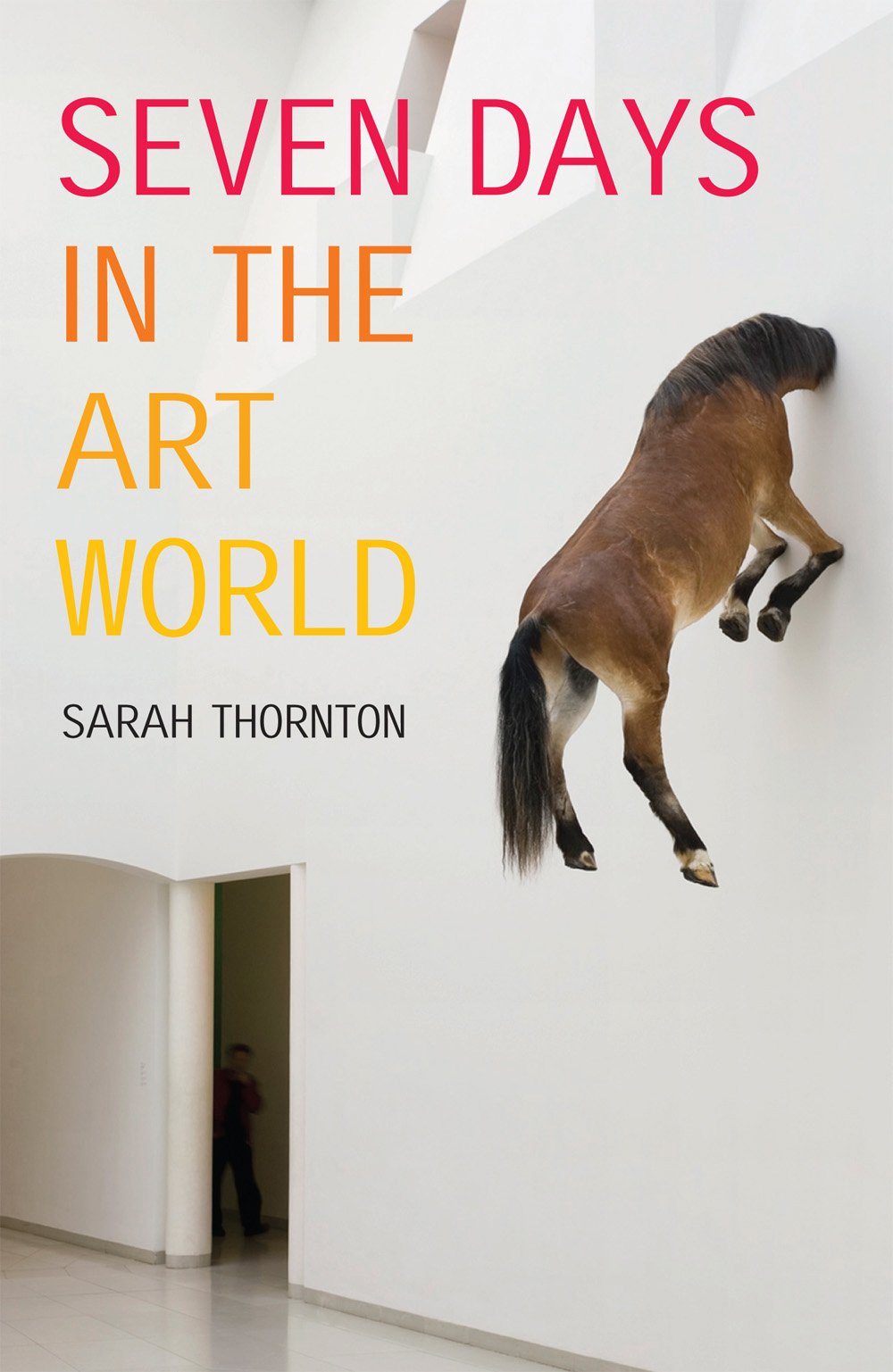
If you are going to buy and read this book, makes sure you have your expectations right. First of all, the title should be: Seven days in the Western art world, and actually the top West part of it! Like New York, LA and London. There are some travels to Japan (also Western, but that in the East, from an American point of view (actually Sarah is from Canada) and Basel (art Basel) but it is not that you will learn much about Japanese culture or the Swiss culture. Also, in Venice it is not necessary about Venice or Italy, it is about business, art business, something I strongly resent. Yes, also artist can make money, but the consumentistic Capitalism behind this, described in this book, is not much else than the Multinationals runed by Old Fat White Privileged People (mostly rich powerful fat man) who avoid paying taxis.
This book is all about the richest of the richest in the artworld and there by a good read, so you learn how to avoid these people and their structures as they are very hierarchical, heliair, rule based (and those are not your rules, until you accept to step in that world as an artist), old friends networks, of which the writer wants to be inside so so much (I think I write that cynical / ironical).
The book is in 7 chapters and so, 7en days. Of which day 6 is Sarah going on a studio visit, where the vulgarity of the art investors really got to me, but also of the artist, in tis example a Japanese artist, the artist Takashi Murakami. I can tell you, there are so many artists out there, also the rich famous elaterin ones where you ask, why? Still, those are, in my opinion, so much more interesting than this one (for example: he is even more commercial than Hirst and Koons combined, so not interesting, and thereby, Koons and Hirst at least started their carreers with interesting and important work), some examples: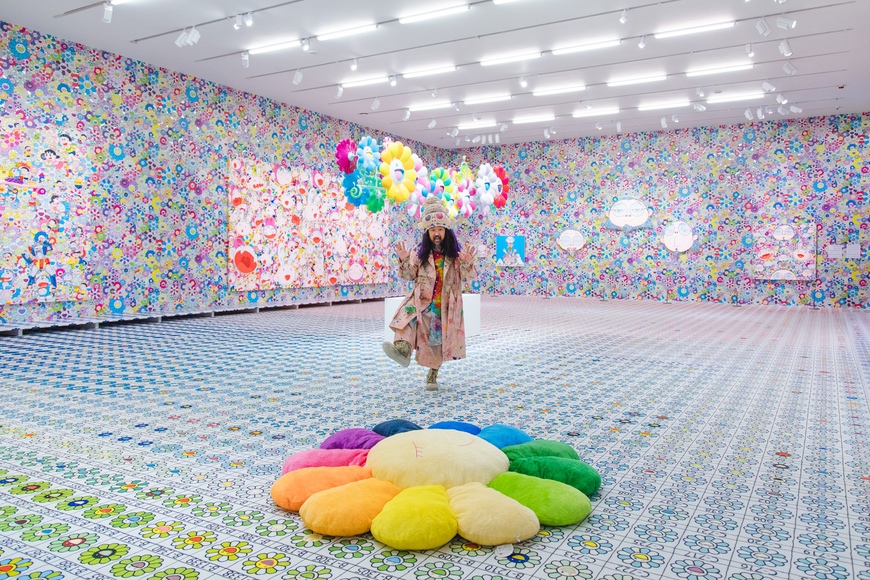
So boring obviously, but of course, it will sell great, but I dare to state, that if you take all his works and thrown them in the ocean, nobody will ever miss them or in 500 years from now, this will have no importance in art history books from than, or maybe, somewhere mentioned in a paragraph as: WTF was this art??
So, there is the ‘West Western Art’ world and the ‘Western artworld’ which is New York, LA, London, Paris, Berlin, Amsterdam, Antwerp, Basel (Art Basel), Milan (design show), Maastricht (TEFAF) and Kassel. I hope I do not forget a city or country, if so, I will add later. What I want to point out with this, that this is quite limited to call The Art World, so, that is way I call it The WESTERN artworld, and I think that is important. Because as you learn that it is almost always about consumentistic capitalistic art and artists (which are not necessarily happy with this, but at the moment they are in this system, they can earn quite some money, if you let go of your autonomist) you can stop your ‘awe’ ‘awesome’ ‘brilliant’ remarks and focus on the other art and artists, those around you where even you are in the west or in the rest of the world. There is so much contemporary art around, also good contemporary art and very much to enjoy. Please keep your eyes open, and if you are going to collect, there is so much out there in Africa, Indonesia, Asia, etc.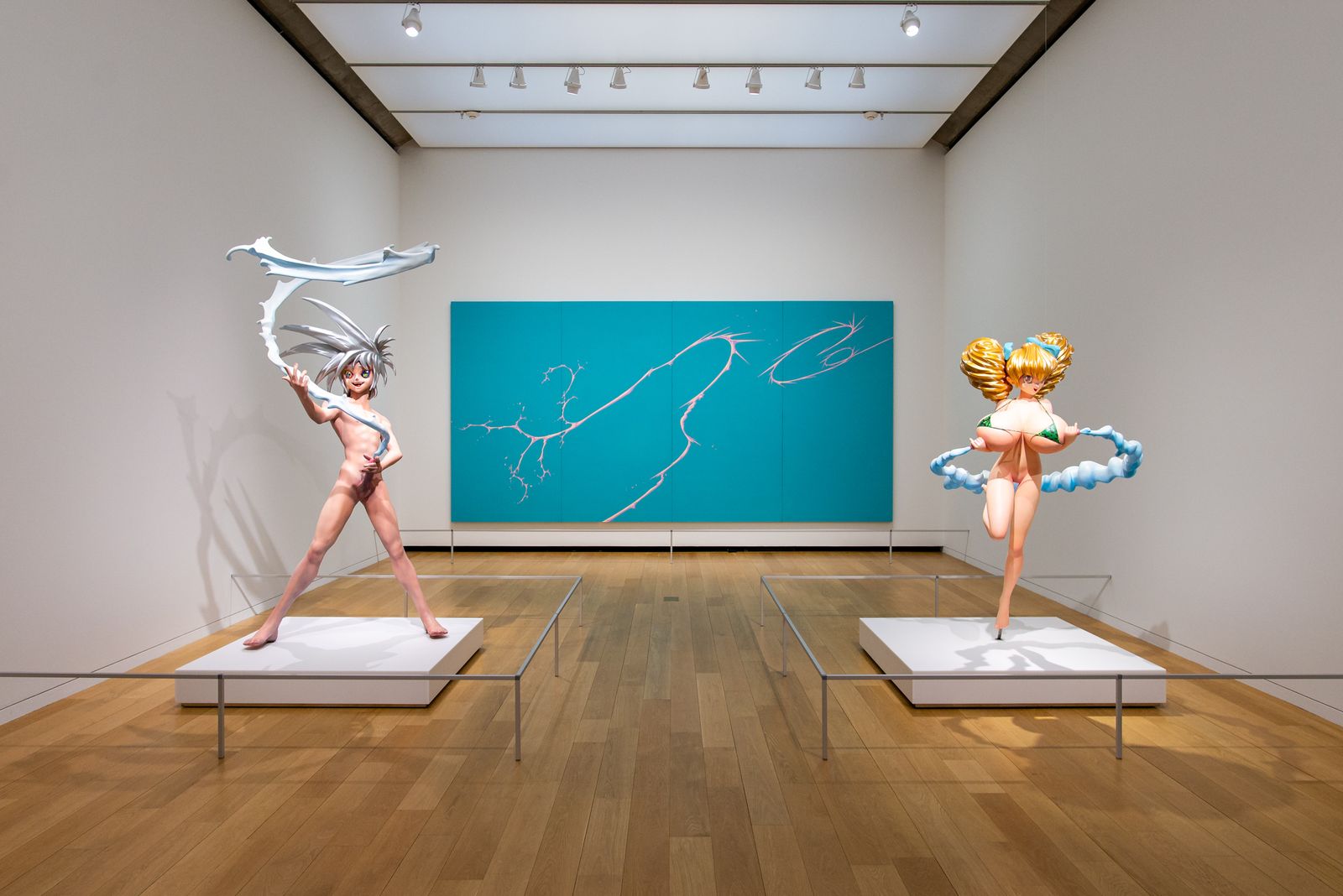
Lees meer >> | 382 keer bekeken
-
WHITE LINE / Site Specific Kroller Muller
24 november 2021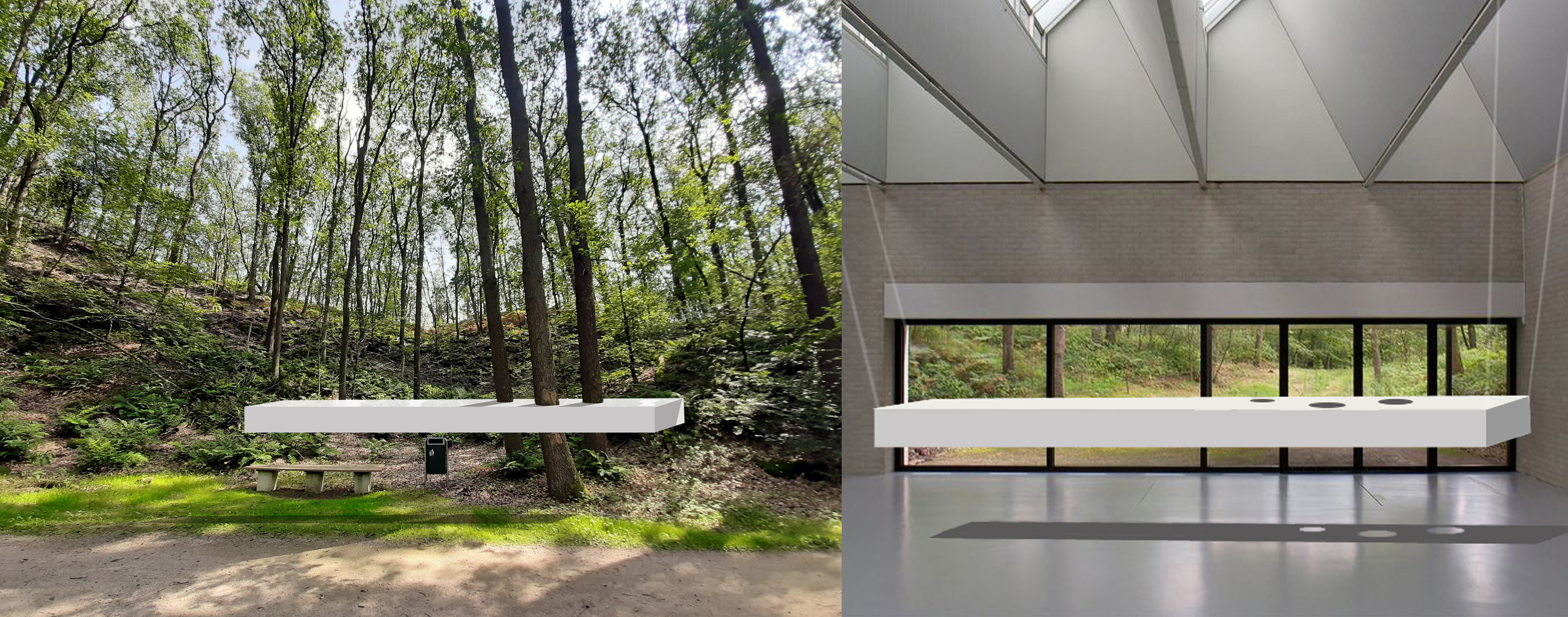
BLOG 006
WHITE LINE
Where nature is tried to be hold and controled by humans, an art installation could be needed to show the oposite.
What you see here is a beautiful empty space in the sculpture park (more related to a forrest) of #krollerMollerMuseum, with a bench and a bin (so, not so empty afterall), of which inspires me for making a 3D sketch, of a white plaster (plaster of Paris / gipsen) blok, around 3 beautiful trees (they will not be harmed in any way, I know what I am doing, I did this before). The sketch you see in the foto. The white blok in this sketch is designed in a way that it forms a communication between the surroundings, the trees, the visitors, bin and bench, and you can see this in a before and after situation, where 'the before' is the untouched space, 'the after' situation suddenly has a new void filled, with white plaster which let you rethink the situation (if you like too).To complete this conceptual installation piece is the same plaster blok inside the museum of Kröller-Müller Museum (in exactly the same time frame of course), free of the trees (but an exact copy, so 3 empty holes), free of the outside elements. It will be protected. An outside camera will film the outside wide element, and project inside, next to the installation inside. See Foto.
The outside element will experience the effects of rain, wind, sun and moving trees (and everything else what nature throws at it), and will start to wear and tear as a result of it. The 2 elements will grow even further apart, the public can see that on the screen next to the inside installation), isn't it sad but also romantic in a way??.
This site specific art installation is interactive in the way that as visitor you are likely to start to think about the realtion between the beem, the benach and the bin, as in the trees are now connected to human behaviour, the need of a beanch an a bin in a forrest, but also if you would sit in the bench, you would likely to feel the weiht of the blok above you, as the sarwd of Damocles. The connection inside you can make as visitor as well, like a compariso is easy made and also the abscense of the trees and the other elements could leed you to think of what is outside and what is inside, in context of the white block, the museum and the nature.Lees meer >> | 339 keer bekeken
-
Easier said than done
10 augustus 2021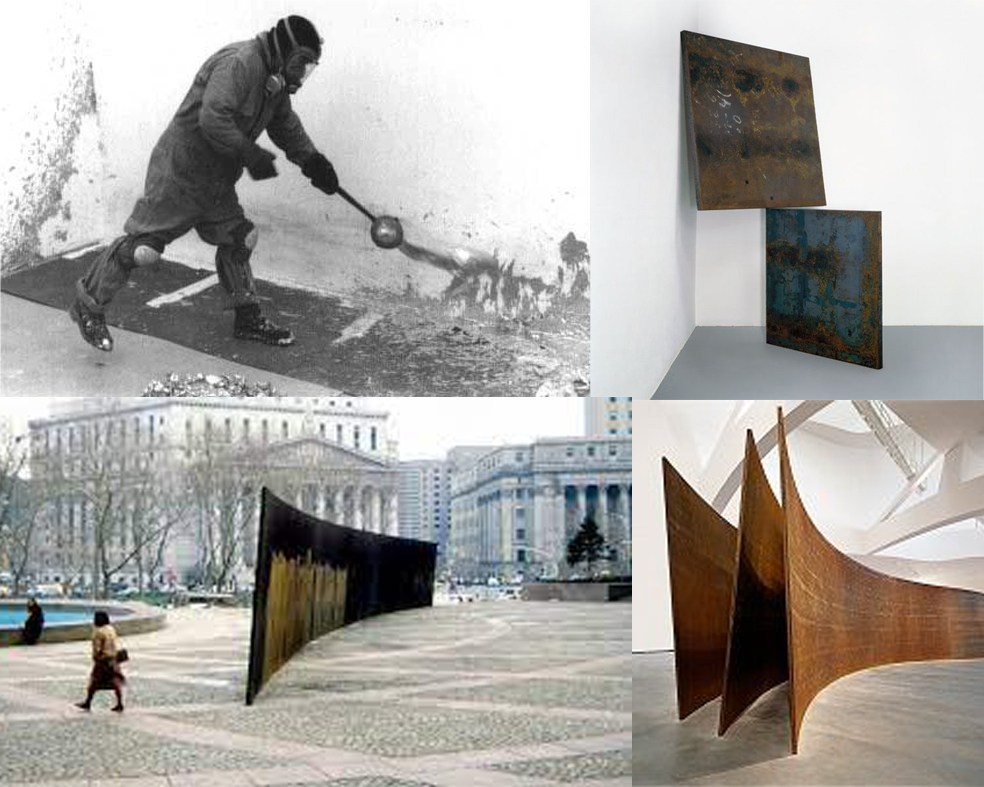
BLOG 005
Great artists who should have evolved or tried new things.
Easier said than doneStarting their careers with promise, Damien Hirst and Jeff Koons have seen little evolution in their work over the past decade; it's become more of the same, driven by commercial interests, as I see it, from my position. The Western art world continues to support them, I guess protecting their market value. However, I find Richard Serra's case more intriguing. Despite his impressive work in the Qatar desert in 2014, I question why artists, who I believe should be critical and engaged, collaborate with Middle Eastern regimes for oil money.
What astounds me is the remarkable creativity and boldness Richard Serra displayed in his early years, evident in his striking works with lead splashes and thick metal gestures, as seen in the photos I post here witht his blog:
These works were more minimalistic, site-specific, and daring, with a raw edge. I began noticing a change in his approach after his presentation at the Venice Biennale in 2001, where he received the Golden Lion. His subsequent works lack the same connection to the space, feeling overly grandiose and sterile. These are personal observations, and I acknowledge that critiquing art practice is not easy. While Serra remains a hero to me, I can't help but feel disheartened by the trend of many great artists resorting to repetitive spectacle, monopolizing the art world and stifling new talent.
It's not solely the artists' fault; the Western art world operates more and more like a business, prioritizing value over artistic growth. This focus on profit makes Western art predictable, sanitized, and ultimately shallow.
I wonder why Western modern and contemporary art institutions struggle to embrace change and veer in new directions. While it's understandable for artists to stick to what brings them success, it doesn't reflect the innovative spirit that made them great in the first place. However, I recognize that my critique may seem simplistic.
Lees meer >> | 328 keer bekeken
-
DRIONs PILL
5 juli 2021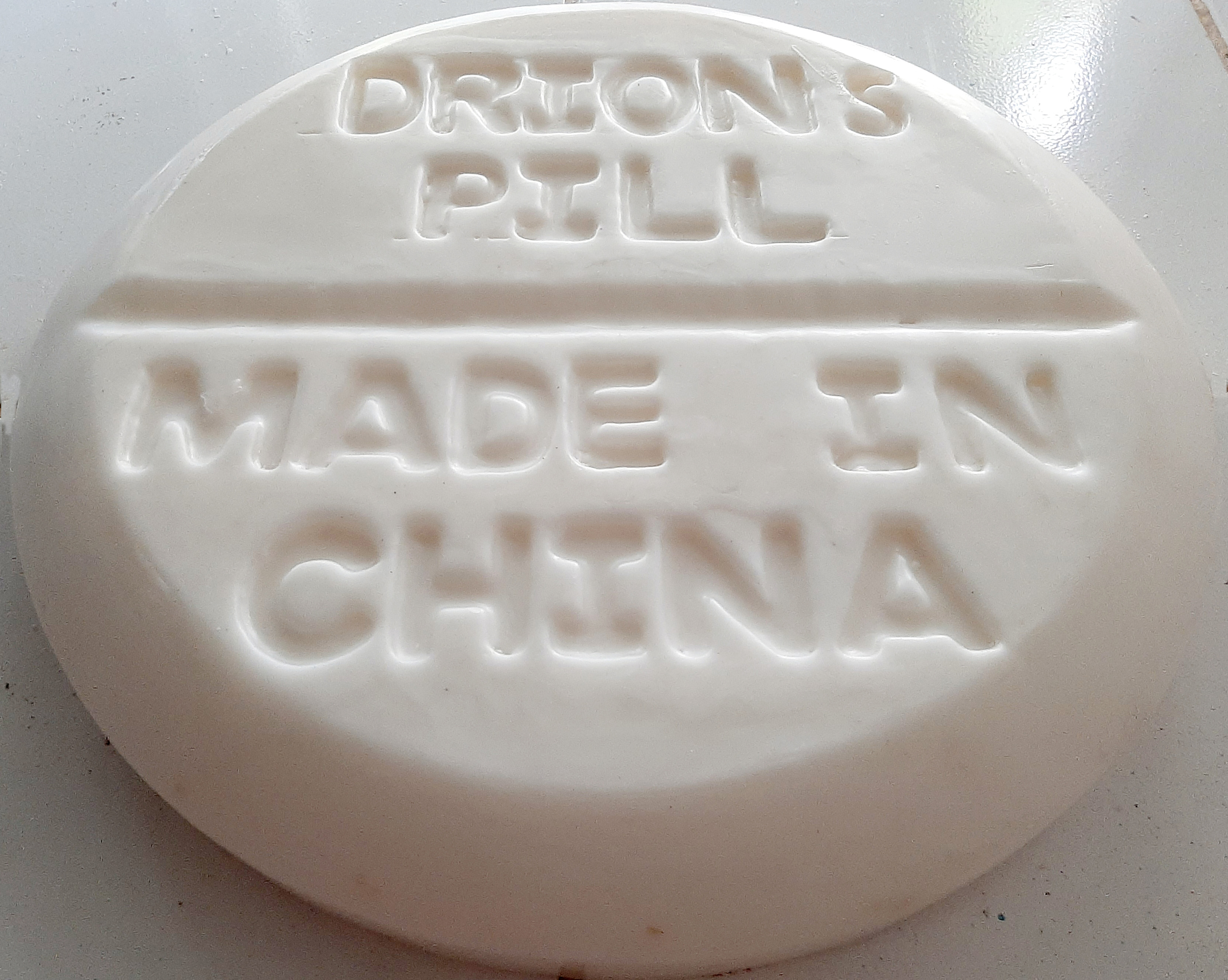
BLOG 004
Drions PILL
white wax / 28-5-2020
I LOVE LIFE / LIVE
Dions PILL doesn't exist yet but should be. It is a hypothetical suicide pill. The pill consists of 2 halves, or 2 pills. You take one and have some days to think it over, when you take the second halve you will die peacefully. If you don’t take the second pill, you live on.
My artwork is celebrating this pill and its “creator” Huib Drion, a former Dutch Supreme Court Judge and professor of civil law and that all the discussion if you are allowed to take your own life, I am suggesting that it will be China again to start making this pill, as this country is full of surprises. One of them is also the COVID-19 virus coming from Wuhan. Yes, it could have been “ created” or coming to existence in another country or wed market, maybe escaped from a laboratory, I am more surprised that all warming systems and responses where in place, but not reacted to and hence the quick existence of a pandemic.
If governments are asking all humans, not in essential jobs, to stay home, you also have to provide metal help, which, until today is not in place or worked on. So, providing mental help, mental structures, etc. But also give people something “humane” if they want to leave their lives. I would also plea for a sleeping pill that let you sleep through a pandemic like this, and the anxiety and panic it is causing.
The reason nothing humane was offered through humans asked to stay home and opposing lockdowns and evening clocks on them, was and is brought op by politicians who have very busy jobs not stopping to go to work themselves. This is unacceptable to me, which is the same level of unacceptance many have, many politicians, to a positive advice on Drions Pill, the same which were supporting these harsh lockdowns, not supporting humane mental solutions or supporting mental healthcare in general. They don’t care, they don’t know and they don’t have visions. Also, on the advisory boards for this pandemic (in Holland that was #OMT and #RIVM) where not people with an intelligence or profession with human behavioural skills. The “behaviour” of a virus is important to know and research, human behaviour even more so, because they are spreading this virus.Lees meer >> | 303 keer bekeken
-
I love Louise
30 juni 2021BLOG 003
One of my favorite artists is Louise Bourgeois (I learned a lot from her, just looking at her art), and not only because she is not an art fair art / market artist (artists like #JeffKoons and #DamienHirst) but a great authentic lady that worked until she died aged 98 in 2010. Her greatest works: The Cells. (See the short video). I once saw her work's / installation / drawings (her night works when she couldn't sleep, She saw those not as artworks, not even sketches) in Berlin, and it was a great exhibition, and it is always after that as meeting old friends when I see work of her again, like the last time in Tate Modern LLees meer >> | 321 keer bekeken